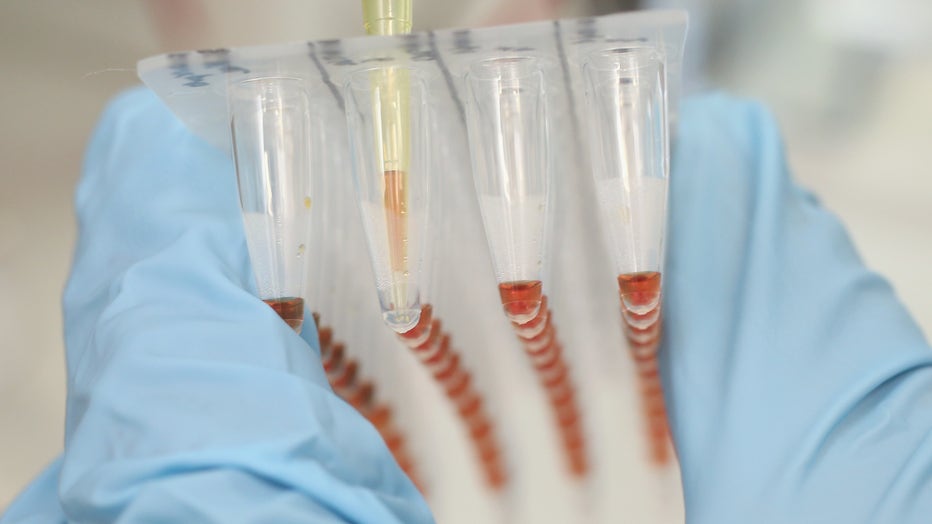Murdered Queens jogger’s family pushing for enhanced DNA testing

A technician holds vials containing engineered DNA. (Photo by Sean Gallup/Getty Images)
By Ese Olumhense in New York for the Tribune Media Wire
Arrest, Confession Reportedly Made in August Murder
A suspect was charged Sunday in the death of Katrina Vetrano, a Queens woman beaten and killed while jogging in the New York borough’s Howard Beach neighborhood more than six months before.
On Saturday evening, Chanel Lewis, 20, was brought in for questioning; he was later charged with second-degree murder in the Vetrano case. Officials say Lewis confessed, providing “detailed incriminating statements” about the crime. His DNA, obtained through a voluntary cheek swab, matched that found under Vetrano’s nails, on her phone, and on her back. If convicted, he faces 25 years to life in prison.
Lewis has no criminal history. Investigators say they found him after reviewing complaints of suspicious persons in the area.
Before the arrest, Vetrano’s family — backed by Queens District Attorney Richard Brown, NYPD Commissioner James O’Neill, and state legislators — had been urging state forensic science officials to authorize a controversial DNA testing method that they believed might have helped catch the suspect sooner.
On Thursday, Vetrano’s parents made a public plea for the New York State Commission on Forensic Science to help investigators find their daughter’s killer by approving the use of targeted familial DNA matching. The method allows investigators to run DNA from a crime scene through existing criminal databases to find a partial match to a biological family member already in the index.
Neither the family nor law enforcement officials apparently had any evidence that Vetrano's killer would have a familial match in the system. New York state does already allow any partial matches in the database to be mined for investigatory leads.
Civil liberties organizations have pushed back on the efforts, citing privacy concerns. The commission has a special hearing regarding the use of familial searching scheduled for February 10.
Familial Matching: What is it?
Since Vetrano’s murder, state lawmakers and city police officials have pushed for the use of familial matching to help identify suspects. Currently 10 states have explicit policies allowing investigators to use familial searching in unsolved cases.
This practice is different from partial DNA matching, a forensic technique used when incriminating biological evidence indicates a partial match to a profile in an existing DNA database, suggesting it came from a relative. In most states, partial matches are excluded by laboratory technicians, but New York allows labs to report partial matches to law enforcement.
Familial searching, a more advanced forensic method, goes beyond partial matching to do a targeted search biological relatives for a given sample.
New York State Senator Phil Boyle (R-Suffolk) introduced a bill in December to allow district attorney’s offices and law enforcement agencies to use familial searching for unsolved violent crimes. Boyle said the “long overdue” tool is one that will help keep the public safe, allowing law enforcement to quickly weed out suspects, or clear others.
The bill passed the New York state Senate Monday afternoon.
Making ‘Perpetual Suspects’
Critics of familial searching argue that the tactic violates the Fourth Amendment rights of people who have no apparent connection to the crime.
“When you involve innocent folks in a criminal investigation as targets on the basis of a familial DNA search, you’re introducing heightened risks that there will be constitutional violations, because you’re dealing with imprecise matches, and you’re dealing with with people who are highly likely to be a non-match,” said said Bob Perry, legislative director at the New York Civil Liberties Union (NYCLU).
Ahead of Friday’s hearing, both the NYCLU and the Legal Aid Society filed memos with the state forensic science commission challenging the constitutionality of adopting targeted familial matching in the state. Both say use of the method should be one considered by the state legislature, and not the commission alone.
As of November 2016, there are more than 615,000 DNA profiles are in New York State’s 22-year-old DNA databank, which is connected to the federal Combined DNA Index System (CODIS). Submitting DNA evidence to the federal and/or state databases has resulted in more than 23,000 matches — but those matches are not necessarily correlated with arrests.
DNA analysis isn’t perfect, and civil liberties advocates suggest that the implications of mistakes go beyond individual cases. Perry says that in New York, where DNA is collected from suspects in a variety of violent and nonviolent offenses, constantly running DNA databases for familial matches would create “perpetual suspects” of innocent people who happen to be related to people who have been arrested — mostly from communities of color.
“Human fallibility enters into the use of DNA, just like every other human endeavor, but we tend to think because we’re using highly sophisticated science that somehow human fallibility and error has somehow been repealed,” Perry says. “It’s not been.”

